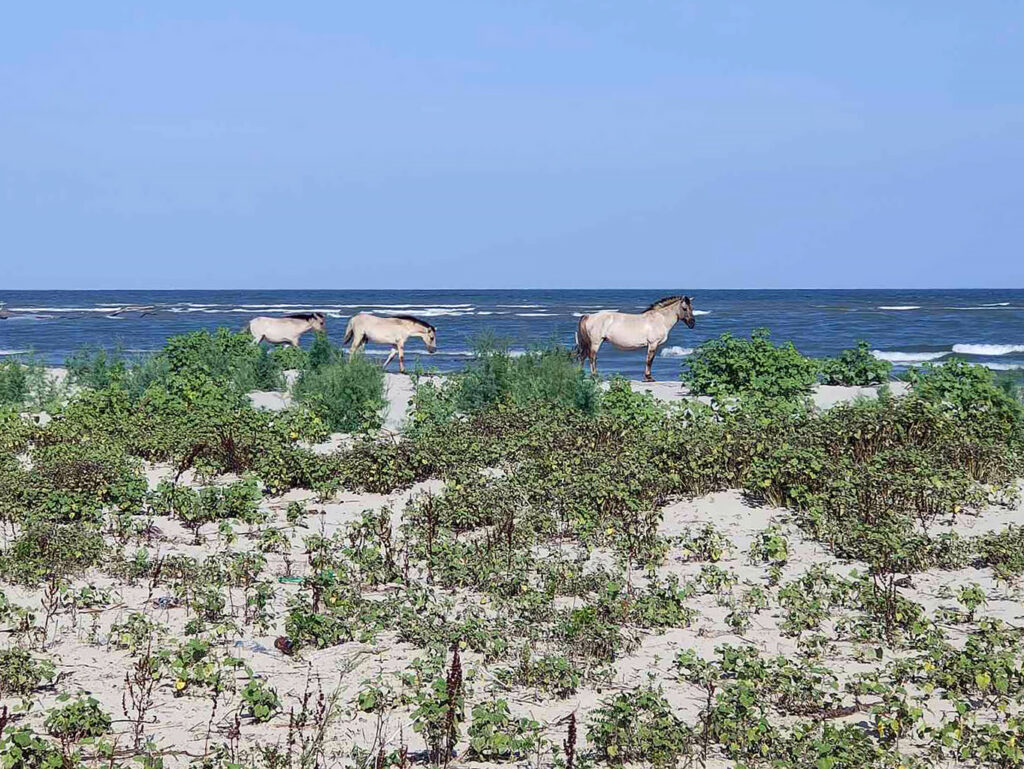Rewilding goes on even in hard times. More than 22 cubs of various species were born in the rewilding areas in the Danube Delta. The Rewilding Ukraine team is delighted that this year’s breeding season in the region went very well despite the war in Ukraine and drought.

In all the working areas, where the team was able to survey this year, the animals that have returned to the region thanks to rewilding efforts of the past three years, are having babies. The most cubs – as many as 8 foals – were born to wild horses Koniks, which came to Ermakiv Island from Latvian reserves. A month ago, a buffalo was also born on Ermakiv. In general, buffaloes give birth to young quite late, so we can hope for further growing of the herd until the end of the year.
The record holder for the number of babies from one mother is a family of steppe marmots that settled in the Tarutino steppe two years ago as the first step in returning the species to the region. In the spring, the female marmot gave birth to 6 little cubs. Although the steppe has natural predators such as the fox and birds of prey, all the young survived and have grown to adult size. In the future, further releases of marmots into the steppe are planned to create a viable population of the species here.
“Over the last century, many natural areas of the region were destroyed, the land was used for agriculture. We restore floodplains and steppes, forests and lakes, returning them to their natural state. But our landscapes are like beautiful theaters without actors – large animals that once lived in the region. Ecosystems are incomplete without them, because animals perform important functions. Together with local partners, we have already been able to return many animals to the delta, such as wild horses, water buffaloes, kulans, marmots and others. And we are very happy when we see their babies. This means that they feel good in the region and can establish themselves here and reach a sufficient number to have a positive impact on natural systems, for example, to restore the process of natural grazing,” Mykhailo Nesterenko, executive director of Rewilding Ukraine, shares his opinion.
Support of natural grazing through the reintroduction of wild species of large herbivores is one of the rewilding tools to restore natural areas. Natural grazing is an important ecological process. Large herbivores support natural meadows, spread seeds, and eat excessive vegetation. The diversity of landscapes created in this way attracts many species of insects, amphibians, birds and other animals. Also, the flora of the region is becoming richer.

Unfortunately, not all areas in the Danube Delta are open to the public or subject to other war-related restrictions. Therefore, the fate of some animals that were released in the region is not known yet. To the moment, there is no information about the herd of Hutsul horses on Tataru Island. Also, most of the owls that settled in the outer delta over the last three years as part of the reintroduction program of the species to the region cannot be traced. Except for one, whose GPS transmitter shows his location.
“Recently, we finally managed to visit some remote areas of the Danube Biosphere Reserve, which have not been accessible since the beginning of the war. We did not know what was happening there and whether the animals were ok. We were especially worried about the wild horses that two years ago settled on the island in the Danube Delta as part of rewilding efforts. But when we reached these areas, a group of Koniks came out to meet us. They look healthy and well fed and moreover have three foals. Unfortunately, we did not see other groups of Koniks. But we hope that they are also doing well,” says Oleksandr Voloshkevich, director of the Danube Biosphere Reserve.

In addition, this year, a baby was born in the herd of kulans, which were released from the acclimatization enclosure into the wild nature of the Tarutino steppe. This is the first kulan to be born here and on European continent in the last few hundred years. Also, the herd of water buffalo, which has been in the steppe since last year, increased by four small buffalo, which are also doing well.
“We monitor the animals in the areas that we can visit now. All babies are feeling well, growing and getting stronger. Of course, we worry about them, and not only because we have put a lot of effort into their return to the region. I always watch animals with delight, and care about them. Nature and man are inseparable and only together can we look to the future with hope. I hope that after the victory, we will be able to restore not only the cities, but also the nature of our country,” says Oleksiy Pudovkin, an animal reintroduction specialist at Rewilding Ukraine.
The wildlife comeback in the Danube Delta is supported by The Endangered Landscapes Programme, managed by the Cambridge Conservation Initiative in partnership with Arcadia, a charitable fund of Lisbet Rausing and Peter Baldwin.